1990 VOLKSWAGEN TRANSPORTER page 54
[x] Cancel search: page 54Page 6 of 165
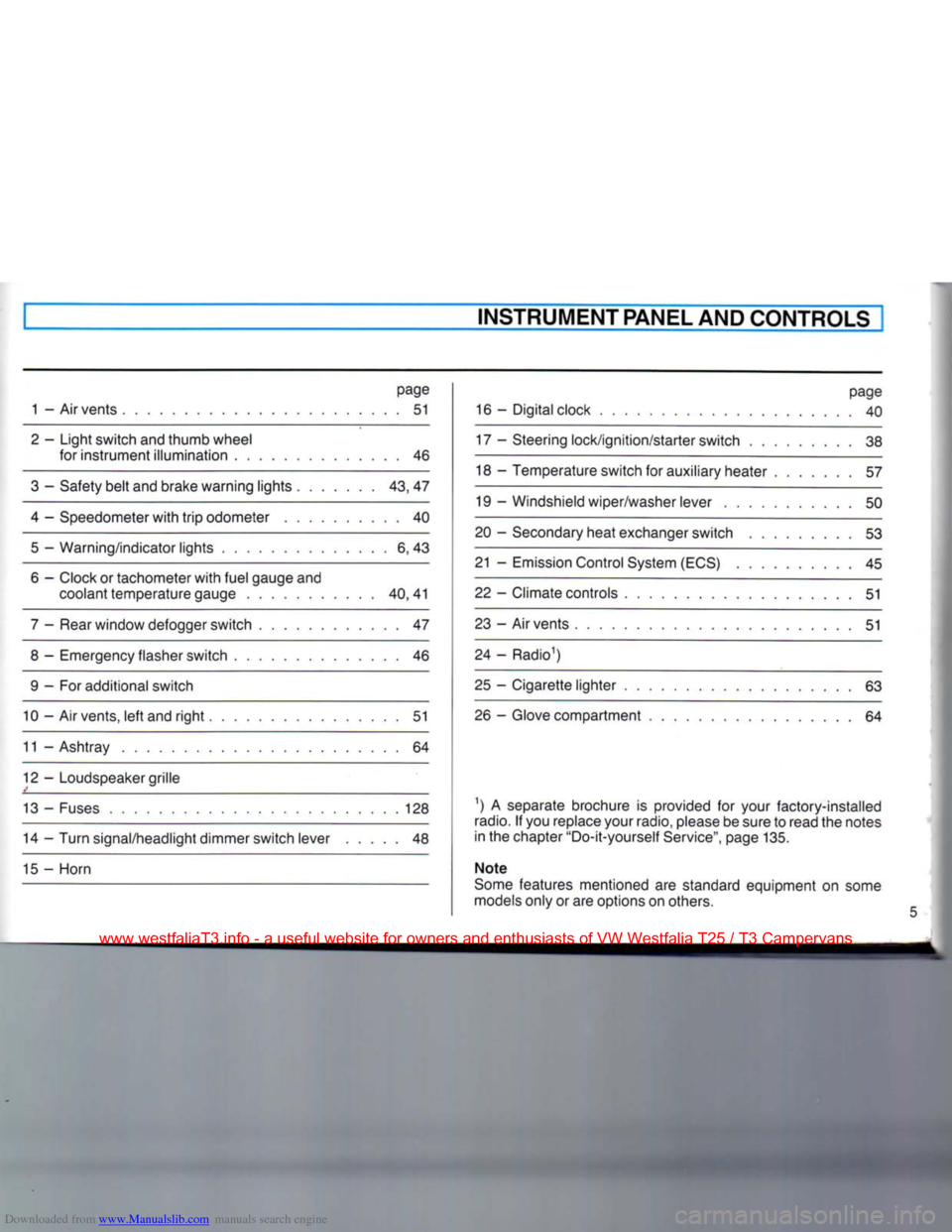
Downloaded from www.Manualslib.com manuals search engine
INSTRUMENT PANEL AND CONTROLS
page
1 - Air vents 51
2 - Light switch and thumb wheel for instrument illumination 46
3 - Safety belt and brake warning lights 43, 47
4 - Speedometer with trip odometer 40 5 — Warning/indicator lights 6, 43
6 - Clock or tachometer with fuel gauge and coolant temperature gauge 40,41
7 - Rear window defogger switch 47
8 - Emergency flasher switch 46 9 - For additional switch
10 - Air vents, left and right 51
11 - Ashtray 64
12 - Loudspeaker grille
13 - Fuses 128 14 - Turn signal/headlight dimmer switch lever 48
15 - Horn page
16 - Digital clock 40
17 - Steering lock/ignition/starter switch 38
18 - Temperature switch for auxiliary heater 57
19 - Windshield wiper/washer lever 50
20 - Secondary heat exchanger switch 53
21 - Emission Control System (ECS) 45
22 - Climate controls 51
23 - Air vents 51
24 - Radio1)
25 - Cigarette lighter 63 26 - Glove compartment 64
1) A separate brochure is provided for your factory-installed
radio.
If you replace your radio, please be sure to read the notes
in the chapter "Do-it-yourself Service", page 135.
Note
Some features mentioned are standard equipment on some
models only or are options on others.
www.westfaliaT3.info - a useful website for owners and enthusiasts of VW Westfalia T25 / T3 Campervans
Page 7 of 165
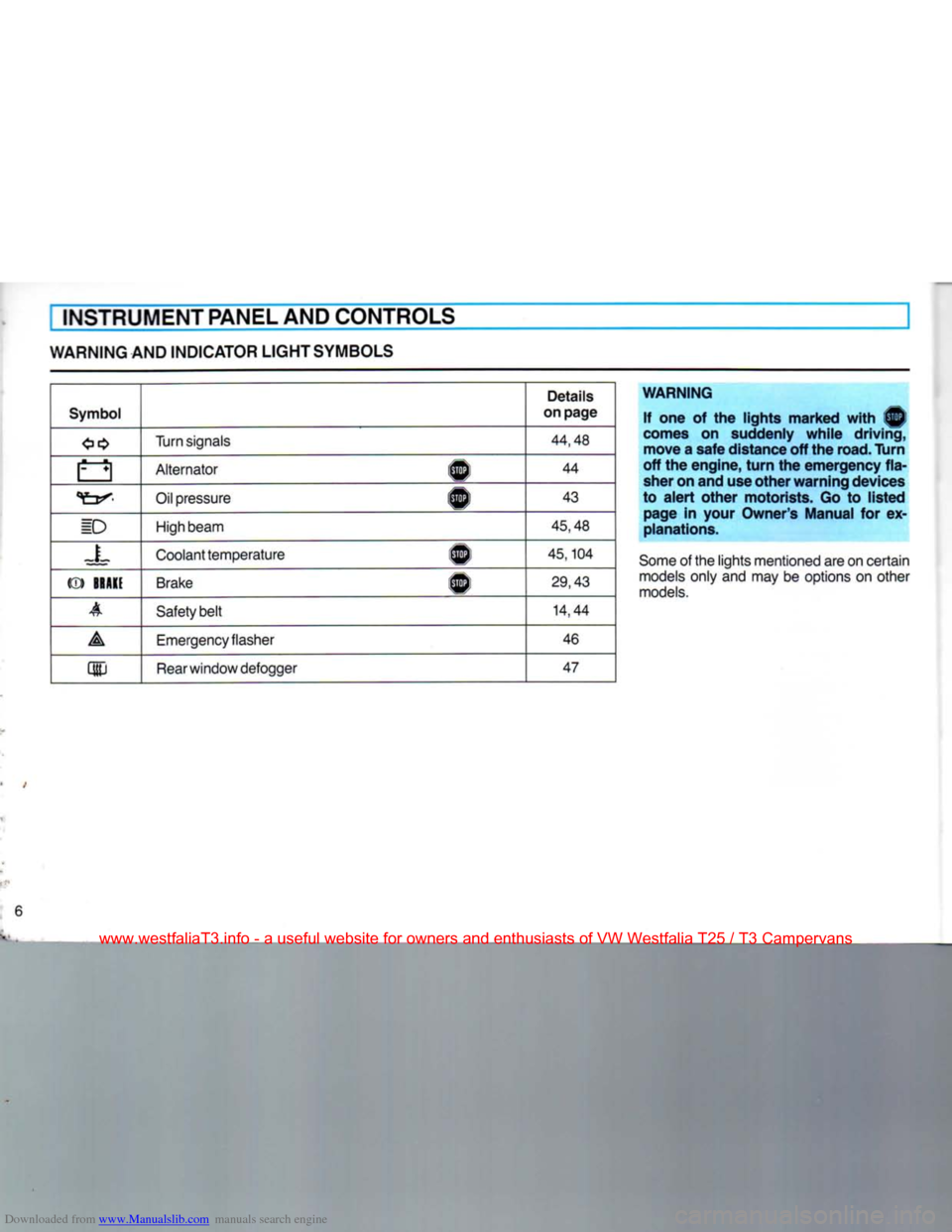
Downloaded from www.Manualslib.com manuals search engine
[INSTRUMENT
PANEL
AND
CONTROLS
WARNING AND
INDICATOR
LIGHT
SYMBOLS
Symbol
Details
on
page
Turn
signals
44,48
a Alternator A
44
Oil pressure 1^1
43
ID
High beam
45,48
=L Coolant temperature 1^
45,104
(®)
BRAKE
Brake
®
29,43
A Safety belt
14,44
A Emergency flasher
46
m
Rear
window defogger
47
WARNING
If one of the lights marked with ®
comes
on suddenly while driving, move a safe distance off the
road.
Turn
off the engine,
turn
the emergency
fla
sher on and use other warning devices
to alert other motorists. Go to listed page in
your
Owner's
Manual for ex
planations.
Some
of the lights mentioned are on certain
models
only and may be options on other
models.
6
www.westfaliaT3.info - a useful website for owners and enthusiasts of VW Westfalia T25 / T3 Campervans
Page 14 of 165
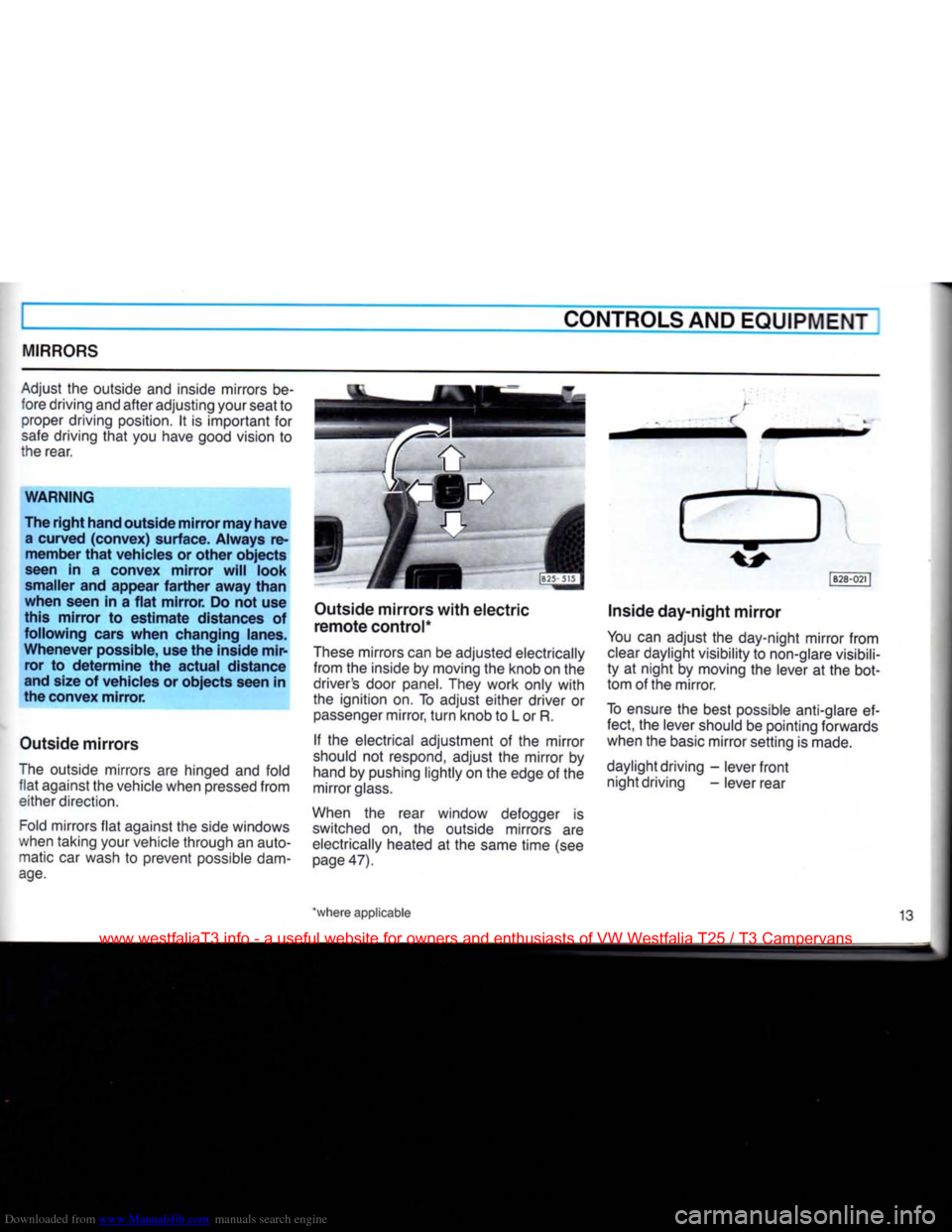
Downloaded from www.Manualslib.com manuals search engine
CONTROLS AND EQUIPMENT
MIRRORS
Adjust
the
outside
and
inside mirrors
be
fore driving and after adjusting your seat
to
proper driving position.
It is
important
for
safe driving that
you
have good vision
to
the rear.
WARNING
The right hand outside mirror may have a curved (convex) surface. Always remember that vehicles or other objects
seen in a convex mirror will look
smaller and appear farther away than
when seen in a flat mirror. Do not use
this mirror to estimate distances of
following cars when changing lanes.
Whenever possible, use the inside mir ror to determine the actual distance
and size of vehicles or objects seen in
the convex mirror.
Outside mirrors
The outside mirrors
are
hinged
and
fold flat against
the
vehicle when pressed from either direction.
Fold mirrors flat against
the
side windows
when taking your vehicle through
an
auto matic
car
wash
to
prevent possible dam
age.
Outside mirrors with electric
remote control*
These mirrors can
be
adjusted electrically from
the
inside
by
moving
the
knob
on the
driver's door panel. They work only with
the ignition
on. To
adjust either driver
or
passenger mirror, turn knob
to L or R.
If
the
electrical adjustment
of the
mirror
should
not
respond, adjust
the
mirror
by
hand
by
pushing lightly
on the
edge
of the
mirror glass.
When
the
rear window defogger
is
switched
on, the
outside mirrors
are
electrically heated
at the
same time
(see
page 47). |B28-021
|
Inside day-night mirror
You
can
adjust
the
day-night mirror from clear daylight visibility
to
non-glare visibili
ty
at
night
by
moving
the
lever
at the
bot
tom
of
the mirror.
To ensure
the
best possible anti-glare
ef
fect,
the
lever should
be
pointing forwards
when
the
basic mirror setting
is
made.
daylight driving
-
lever front night driving
-
lever rear
*where applicable 13
www.westfaliaT3.info - a useful website for owners and enthusiasts of VW Westfalia T25 / T3 Campervans
Page 15 of 165
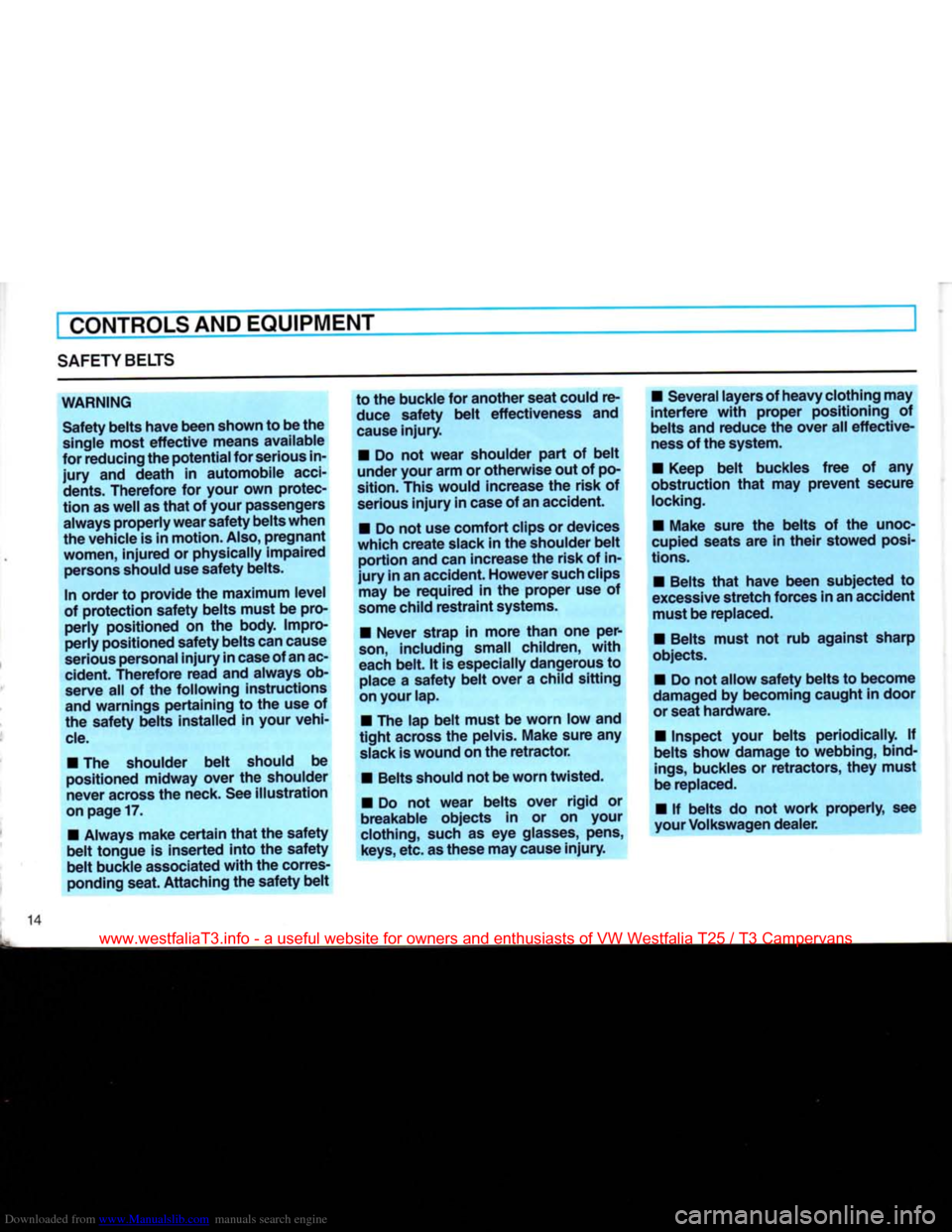
Downloaded from www.Manualslib.com manuals search engine
CONTROLS
AND
EQUIPMENT
SAFETY
BELTS
WARNING Safety belts have been shown to be the
single most effective means available
for reducing the
potential
for serious in
jury
and death in automobile
acci
dents.
Therefore
for
your
own protec
tion as well as that of
your
passengers always properly wear safety
belts
when
the vehicle is in
motion.
Also, pregnant
women,
injured or physically impaired persons should use safety belts.
In order to provide the maximum level
of protection safety belts must be pro perly positioned on the
body.
Impro
perly positioned safety belts
can
cause
serious personal
injury
in
case
of
an
ac
cident.
Therefore
read and always ob serve all of the following instructions
and warnings pertaining to the use of
the safety belts installed in
your
vehi
cle.
•
The shoulder belt should be
positioned midway
over
the shoulder
never
across the neck. See illustration
on page
17.
•
Always make certain that the safety
belt tongue is inserted into the safety
belt buckle associated with the corres
ponding seat. Attaching the safety belt to the buckle for another seat could re
duce safety belt effectiveness and
cause
injury.
•
Do not wear shoulder part of belt
under
your
arm
or otherwise out of po
sition.
This
would increase the risk of
serious
injury
in case of
an
accident.
•
Do not use comfort clips or devices
which create slack in the shoulder belt portion and can increase the risk of in
jury
in an accident.
However
such clips may be required in the proper use of
some
child restraint systems.
•
Never
strap in more than one per
son,
including
small
children, with
each
belt. It is especially dangerous to
place
a safety belt
over
a child sitting
on
your
lap.
•
The lap belt must be
worn
low and
tight across the pelvis. Make sure any
slack
is wound on the retractor.
•
Belts should not be
worn
twisted.
•
Do not wear belts
over
rigid or
breakable
objects in or on
your
clothing,
such as eye glasses, pens,
keys,
etc. as these may cause
injury.
•
Several layers of
heavy
clothing
may
interfere with proper positioning of
belts
and reduce the
over
all effective
ness
of the system.
•
Keep belt buckles free of any
obstruction that may
prevent
secure
locking.
•
Make sure the belts of the unoc
cupied seats are in their stowed posi
tions.
•
Belts that have been subjected to
excessive stretch forces in
an
accident must be replaced.
•
Belts must not rub against sharp
objects.
•
Do not allow safety belts to become
damaged
by becoming caught in door
or seat hardware.
•
Inspect
your
belts periodically. If
belts
show damage to webbing, bind
ings,
buckles or retractors,
they
must
be replaced.
•
If belts do not work properly, see
your
Volkswagen dealer.
www.westfaliaT3.info - a useful website for owners and enthusiasts of VW Westfalia T25 / T3 Campervans
Page 16 of 165
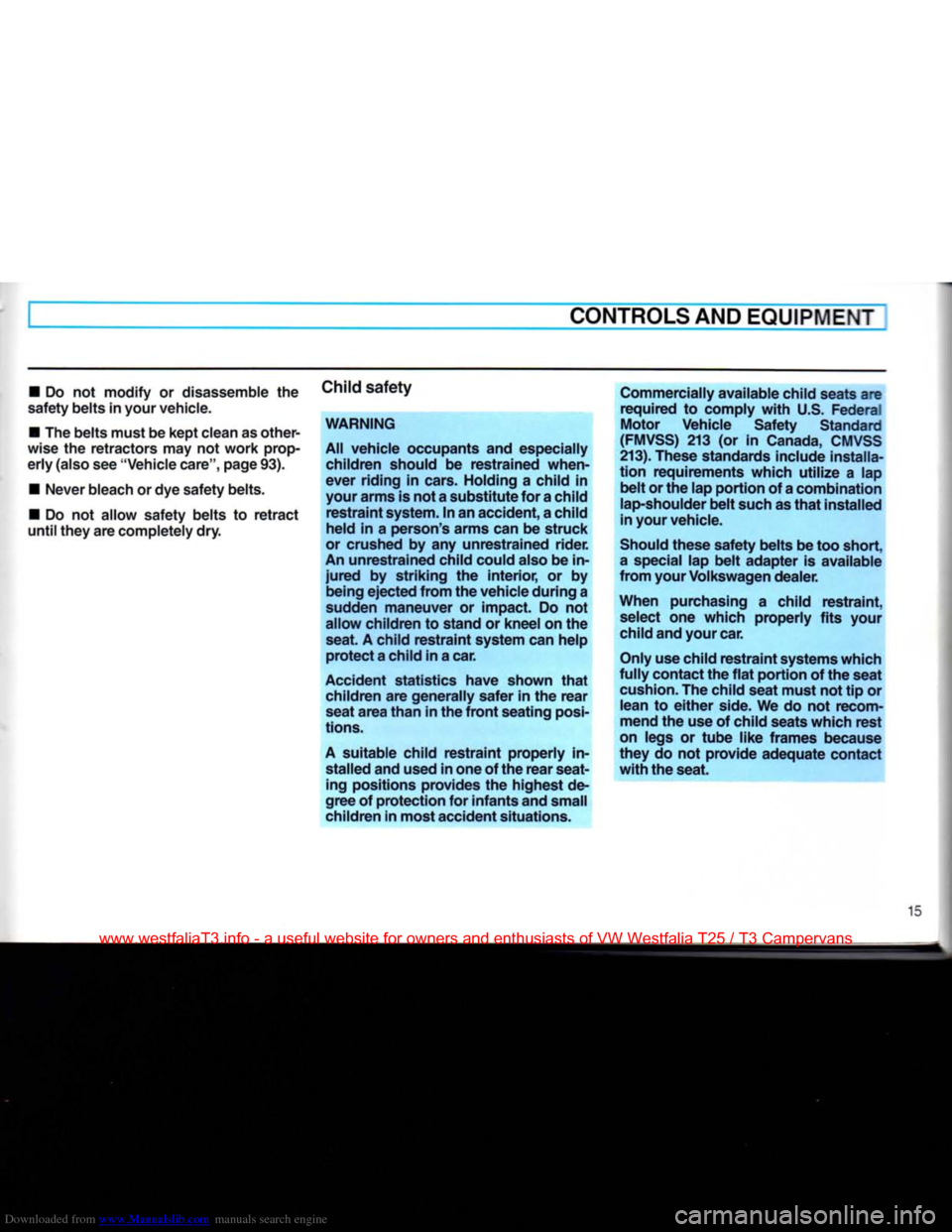
Downloaded from www.Manualslib.com manuals search engine
CONTROLS
AND
EQUIPMENT
• Do not modify or disassemble the
safety belts in
your
vehicle.
• The belts must be kept clean as other
wise the retractors may not work prop
erly
(also see "Vehicle care", page 93).
•
Never
bleach or dye safety belts.
• Do not allow safety belts to retract
until
they
are completely dry. Child safety
WARNING
All
vehicle occupants and especially children should be restrained when
ever
riding in cars. Holding a child in
your
arms is not
a
substitute for
a
child restraint system. In an accident,
a
child
held in a person's arms can be struck
or crushed by any unrestrained rider.
An unrestrained child could also be in
jured
by striking the interior, or by
being
ejected from the vehicle during a
sudden maneuver or impact. Do not
allow children to stand or kneel on the
seat.
A child restraint system can help protect
a
child in
a
car.
Accident statistics have shown that children are generally safer in the rear
seat area than in the
front
seating posi
tions.
A suitable child restraint properly in
stalled
and used in one of the rear seat
ing
positions provides the highest de
gree of protection for infants and
small
children in most accident situations. Commercially available child seats are
required to comply with U.S. Federal
Motor Vehicle Safety Standard
(FMVSS)
213 (or in Canada, CMVSS
213).
These
standards include
installa
tion requirements which utilize a lap belt or the lap portion of
a
combination lap-shoulder belt such as that installed
in
your
vehicle.
Should these safety belts be too short,
a
special lap belt adapter is available
from
your
Volkswagen dealer.
When purchasing a child restraint, select one which properly fits
your
child and
your
car.
Only
use child restraint systems which
fully contact the flat portion of the seat
cushion.
The child seat must not tip or
lean
to either side. We do not recom
mend the use of child seats which rest
on legs or tube
like
frames because
they
do not provide adequate contact
with the seat.
15
www.westfaliaT3.info - a useful website for owners and enthusiasts of VW Westfalia T25 / T3 Campervans
Page 17 of 165
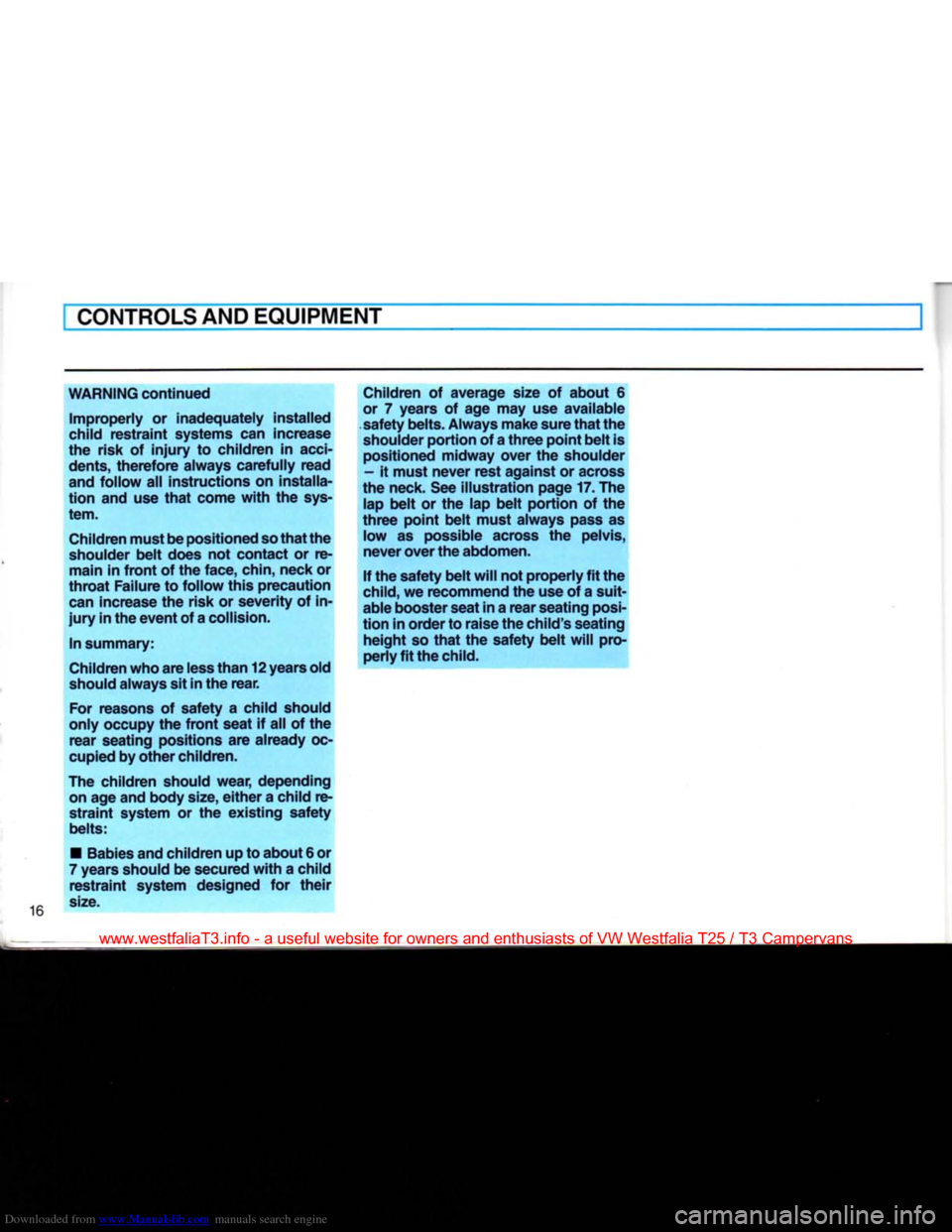
Downloaded from www.Manualslib.com manuals search engine
CONTROLS
AND
EQUIPMENT
WARNING continued
Improperly
or inadequately installed
child
restraint systems can increase
the risk of
injury
to children in
acci
dents, therefore always carefully read
and follow all instructions on
installa
tion and use that come with the sys
tem.
Children
must
be
positioned so
that
the
shoulder belt does not contact or re
main
in
front
of the face,
chin,
neck or
throat Failure to follow this precaution
can
increase the risk or severity of in
jury
in the
event
of
a
collision.
In summary:
Children who are
less
than
12
years old
should always sit in the rear. For reasons of safety a child should
only occupy the
front
seat if all of the rear seating positions are already oc
cupied by other children.
The children should wear, depending on age and
body
size, either
a
child re
straint system or the existing safety
belts:
•
Babies and children up to about
6
or
7
years should be secured with a child restraint system designed for their
size.
Children of average size of about 6
or 7 years of age may use available
safety belts. Always
make
sure that the
shoulder portion of
a
three point belt is
positioned midway
over
the shoulder
-
it must
never
rest against or across
the neck. See illustration page
17.
The
lap
belt or the lap belt portion of the
three point belt must always pass as low as possible across the pelvis,
never
over
the
abdomen.
If the safety belt will not properly fit the
child,
we recommend the use of a suit
able
booster seat in a rear seating
posi
tion in order to raise the child's seating height so that the safety belt will pro
perly fit the
child.
www.westfaliaT3.info - a useful website for owners and enthusiasts of VW Westfalia T25 / T3 Campervans
Page 18 of 165
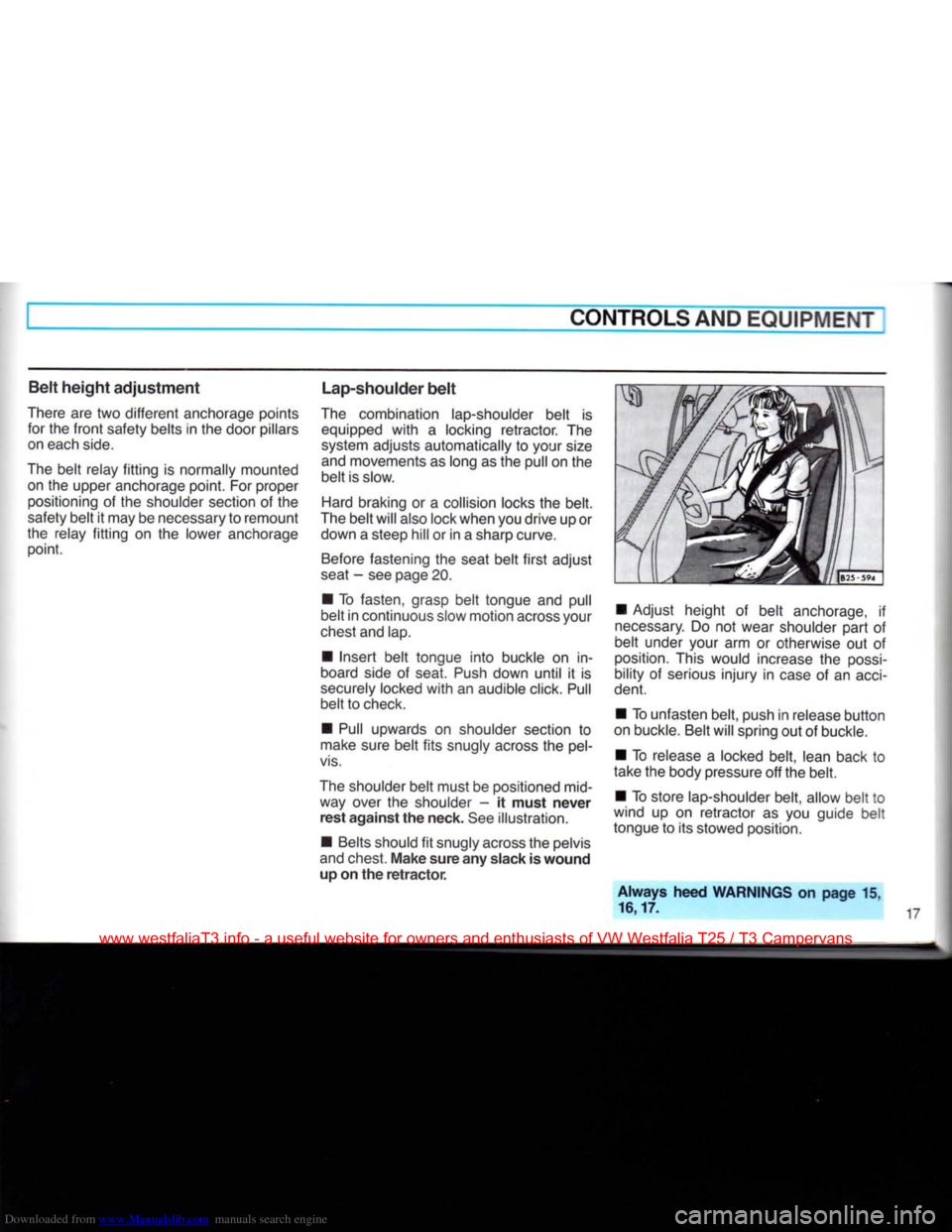
Downloaded from www.Manualslib.com manuals search engine
CONTROLS AND
EQUIPMENT
Belt
height
adjustment
There
are two different anchorage points for the
front
safety belts in the door pillars on each
side.
The
belt relay
fitting
is normally mounted on the upper anchorage point. For proper positioning of the shoulder section of the
safety belt it may be necessary to remount
the relay
fitting
on the lower anchorage point. Lap-shoulder
belt
The
combination lap-shoulder belt is equipped
with
a locking retractor. The
system
adjusts automatically to your
size
and
movements as long as the pull on the
belt is slow.
Hard
braking or a collision locks the belt.
The
belt will also lock when you drive up or down a steep hill or in a sharp curve.
Before
fastening the seat belt
first
adjust
seat
- see page 20.
• To fasten, grasp belt tongue and pull
belt in continuous slow motion across your
chest
and lap.
• Insert belt tongue into buckle on in
board side of seat.
Push
down until it is
securely
locked
with
an audible click.
Pull
belt to check.
•
Pull
upwards on shoulder section to
make
sure belt
fits
snugly across the
pel
vis.
The
shoulder belt must be positioned mid way over the shoulder - it
must
never
rest
against
the neck. See illustration.
• Belts should fit snugly across the pelvis
and
chest.
Make
sure any slack is
wound
up on the
retractor.
• Adjust height of belt anchorage, if
necessary.
Do not wear shoulder part of
belt under your arm or otherwise out of
position.
This would increase the
possi
bility of serious injury in
case
of an
acci
dent.
• To unfasten belt, push in release button
on buckle. Belt will spring out of buckle.
• To release a locked belt, lean back to
take the body pressure off the belt.
• To store lap-shoulder belt, allow belt to
wind up on retractor as you guide belt
tongue to its stowed position.
Always
heed
WARNINGS
on
page
15.
16,17.
www.westfaliaT3.info - a useful website for owners and enthusiasts of VW Westfalia T25 / T3 Campervans
Page 19 of 165
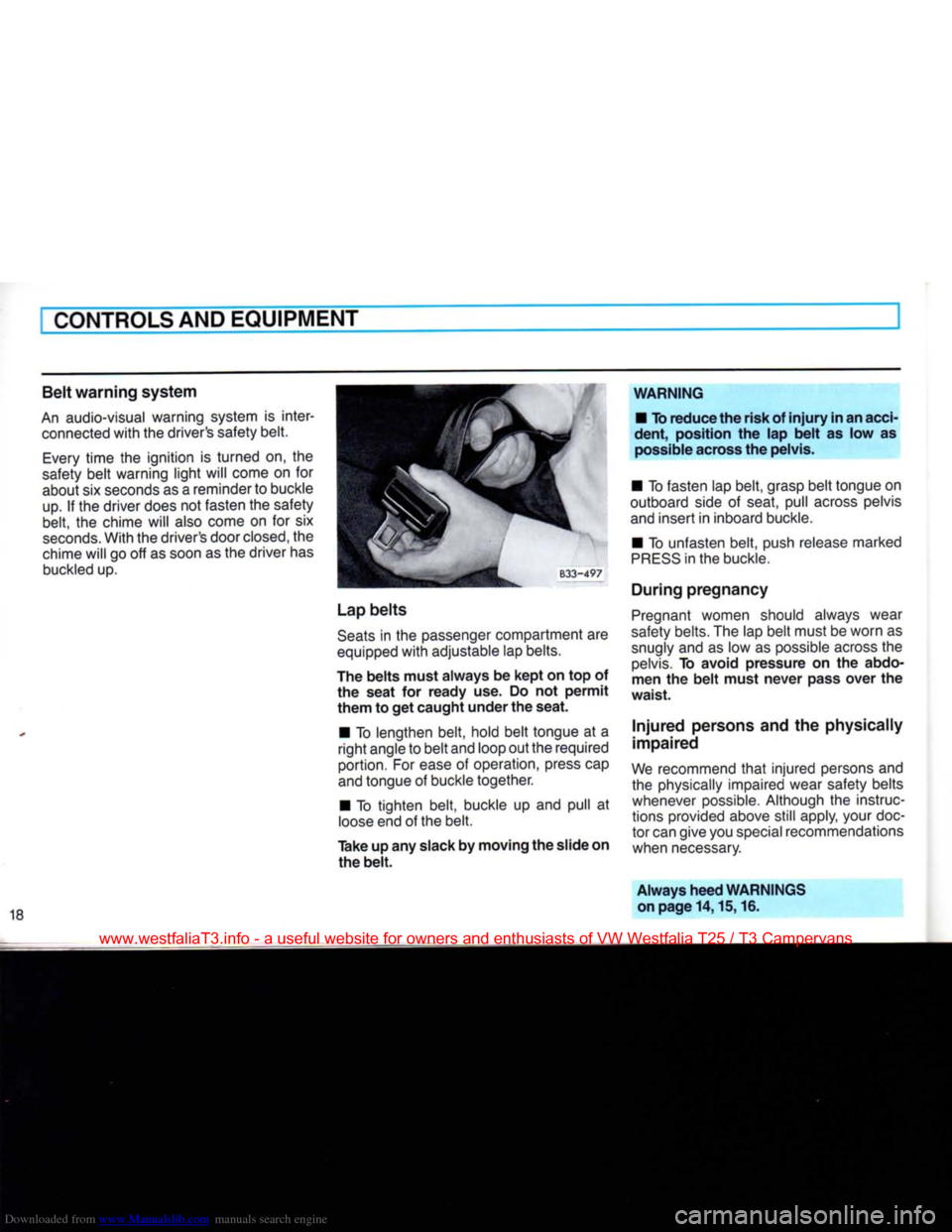
Downloaded from www.Manualslib.com manuals search engine
CONTROLS AND EQUIPMENT
Belt
warning
system
An
audio-visual warning system is inter
connected
with
the driver's safety belt.
Every
time the ignition is turned on, the
safety belt warning light will come on for about six seconds as a reminder to buckle
up.
If the driver does not fasten the safety
belt, the chime will also come on for six
seconds.
With the driver's door
closed,
the
chime will go off as soon as the driver has
buckled
up.
Lap
belts
Seats
in the passenger compartment are
equipped
with
adjustable lap belts.
The
belts
must
always
be
kept
on top of the
seat
for
ready
use. Do not
permit
them
to get
caught
under
the
seat.
• To lengthen belt, hold belt tongue at a
right
angle to belt and loop out the required
portion. For
ease
of operation, press cap
and
tongue of buckle together.
• To tighten belt, buckle up and pull at
loose
end of the belt.
Take
up any slack by
moving
the slide on the
belt.
WARNING
• To
reduce
the
risk
of
injury
in an acci
dent,
position the lap
belt
as low as
possible across the pelvis.
• To fasten lap belt, grasp belt tongue on
outboard side of seat, pull across pelvis
and
insert in inboard buckle.
• To unfasten belt, push release marked
PRESS
in the buckle.
During
pregnancy
Pregnant
women should always wear
safety belts. The lap belt must be worn as
snugly and as low as possible across the
pelvis.
To avoid pressure on the abdo
men the
belt
must
never
pass
over
the
waist.
Injured
persons and the physically
impaired
We
recommend
that
injured persons and the physically impaired wear safety belts
whenever possible. Although the instruc
tions provided above still apply, your doc
tor can give you special recommendations
when necessary.
Always
heed
WARNINGS
on
page
14,15,16.
www.westfaliaT3.info - a useful website for owners and enthusiasts of VW Westfalia T25 / T3 Campervans